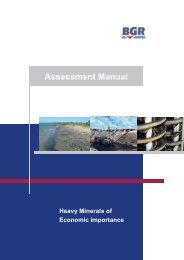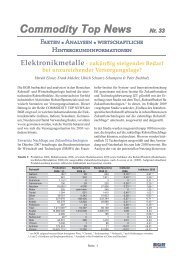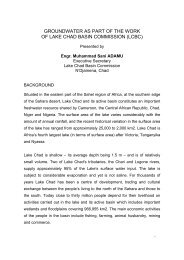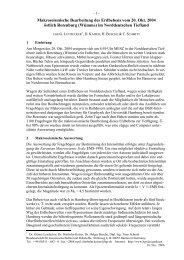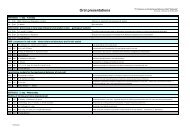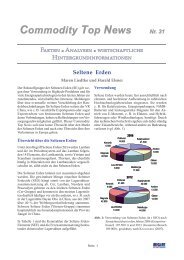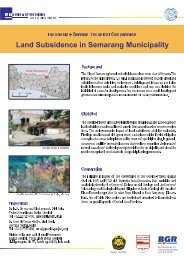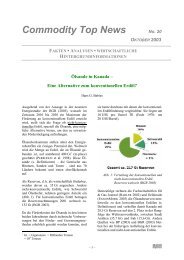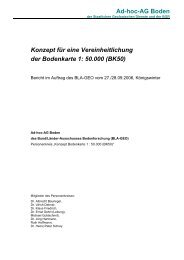THE SMOOTH SOUNDING GRAPH. A Manual for Field Work ... - BGR
THE SMOOTH SOUNDING GRAPH. A Manual for Field Work ... - BGR
THE SMOOTH SOUNDING GRAPH. A Manual for Field Work ... - BGR
You also want an ePaper? Increase the reach of your titles
YUMPU automatically turns print PDFs into web optimized ePapers that Google loves.
39<br />
wireless communication is not permitted.<br />
Knowing how to go on from the initial arrangement L/2=1,5m, a/2=0,5m<br />
we shall proceed step by step looking into the minute book dated<br />
11.Sept.1974 during a survey in the Kalantan-delta around Kota Bharu in<br />
Malaysia near to the coast of the South China Sea. Sounding graph 54 is<br />
concerned. The original data are given on page 40.<br />
As an exercise the reader now should take a sheet of transparent bi-log.<br />
paper and plot the sounding graph after the minute book and the advices<br />
given in the following text.<br />
The initial reading with L/2=1,5m, a/2=0,5m is 164 within the U-range of<br />
300 mV putting the current intensity to 6.28 within the 10 mA-range. This<br />
means from <strong>for</strong>mula (13) an apparent resistivity ρa=164Ωm. We plot this<br />
value on the transparent bi-log paper and write it in order to be sure on<br />
the scale just at this point in the diagram. As long as we use the tech-<br />
nique of putting I=K we only write the range of mV and mA in the minute<br />
book and denote the ρa-value at the right.<br />
Going on with L/2=2,5 m we get an ascending branch up to a maximum<br />
at about L/2=5m. After this a descending branch is recorded until below<br />
100Ωm (L/2=25m) the U-voltage decreases below 10mV. Here we shift<br />
the potential electrodes following the description in chapter 1.6 by a proc-<br />
ess of overlapping the curve branches. In the bi-log. diagram the left<br />
branch should be plotted in small circles (◦) the following branch in<br />
crosses (+). As we shift within the curve minimum we get crossing<br />
branches due to the theory explained in chapter 1.6 (Fig.22).<br />
In this case both pairs of potential electrodes MN and M’N’ were con-<br />
nected to the instrument by using double coil as shown in Fig.26 and 27.<br />
Thus the overlapping could be done by switching from a/2=0,5m to<br />
a/2=5m at the instrument at 3 positions of the current electrodes:<br />
L/2=25, 30, 40m. The advantage of this procedure is obvious: The assis-<br />
tants at the current electrodes A and B will not be aware of the overlap-<br />
ping process. They are marching straight on without being irritated. Call-<br />
ing them back and <strong>for</strong>ward which cannot be avoided when using only sin-<br />
gle coils to the potential electrodes often mistakes will happen as known



